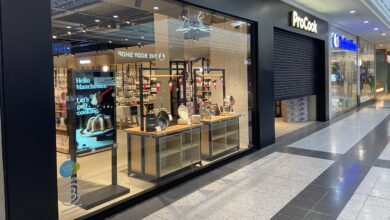Geoff Lloyd warns on expected ‘greater demand’ this Black Friday
The director of retail at NTT Data UK&I shares with us some insights into their recent Black Friday research, what motivates people to not participate, and the shopping slump retailers should anticipate in 2023

Register to get 1 free article
Reveal the article below by registering for our email newsletter.
Want unlimited access? View Plans
Already have an account? Sign in
What led to you becoming director of retail and what responsibilities come with the role?
My career began on the shopfloor at Next where I fell in love with the industry. Technology was starting to have an impact on how retail worked, which was something that I found fascinating. This led to my involvement in projects as a retailer, and over time I moved across to the technology side as a retail technology specialist. Today, my responsibilities are centred on helping our retailers choose and implement technology that enables them to serve their customers better, solve their business challenges and be successful. It’s an incredibly fast-paced and exciting industry to work in, and I’m extremely grateful to have witnessed and been involved in its ongoing transformation.
Out of all the findings from the group’s Black Friday research, which ones surprised you the most, and why?
In general, our Black Friday research findings compounded what we already suspected. Many consumers are feeling the strain from the cost-of-living crisis and inflation, which now sits at a record high of 11.1%. However, the statistic I would categorise as ‘most’ surprising is that two-thirds of consumers stated that they are going to take advantage of Black Friday deals next week to assist with their Christmas shopping.
Black Friday has often been a date when people can plan their gifts for Christmas, but there is a huge increase in people that will be relying on this date this year to save money where possible, spread the cost and ensure that they can buy the gifts they want to give this Christmas. With this in mind, this year retailers need to ensure they are ready for greater demand.
According to the research, 14% definitely won’t participate in Black Friday. What do you think influenced this decision and why?
There are a number of factors that could contribute to a consumer not wanting to be a part of Black Friday. For one, with prices on the uptick all around, some shoppers may not have the means to purchase Christmas gifts this year – a primary reason for Black Friday shopping participation. The current cost-of-living crisis means there will be a bigger strain on families who need to make sure they have enough money to pay for essentials, like heating their homes and feeding their families, instead of shopping for TVs, toys, appliances, and other popular Black Friday items.
Another reason consumers may opt out of the shopping holiday this year is that they don’t want to feel pressured into purchasing products they don’t need or haven’t fully thought through.
Why do you think there’s a correlation between Black Friday shopping and young people?
Young shoppers may not be as concerned with the ‘bigger picture,’ and the cost-of-living crisis. However, one thing they are afraid of is the fear of missing out (FOMO).
Black Friday is an annual retail event where shoppers not only benefit from deals and discounts, but they can also visit their favourite stores at unusual hours and make an experience out of the day. There’s often a rush as shoppers hunt for bargains on the day, both in-store and online, and this excitement can appeal to the younger generation, too. Younger shoppers also tend to have smaller shopping budgets than adults, meaning that Black Friday may be the one day of the year when they can afford items they’ve been wanting.
After the Christmas shopping period, what are your predictions for retail in the starting months of 2023?
The retail industry will be in the midst of a shopping stall at the start of 2023 as consumers will still be penny-pinching due to the cost-of-living crisis, ensuring they have enough money for essentials.
Although supply chain woes may start to ease following the Golden Quarter, the general retail industry will continue to struggle as long as inflation and energy prices stay high, and the cost-of-living crisis continues. Because of this, retailers are in a challenging position; revenue versus profitability, loyalty versus lost customers.
To protect against further squeezes on margins in 2023, retailers need to consider how they can secure margins, while delivering competitive pricing. Significant structural change is critical, and it all starts with reviewing the supply chain, optimising core processes, and finding the agility to transform in an ever-evolving marketplace.







